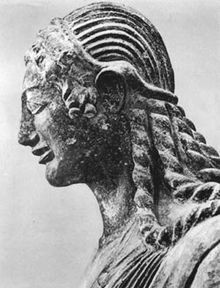
Back Апалон Вейскі Byelorussian Apol·lo de Veïs Catalan Apollon von Veji German Apolo de Veyes Spanish Veiiko Apoloren estatua Basque Vejin Apollo Finnish Apollon de Véies French Apollo di Veio Italian Аполон од Веи Macedonian Apollo van Veii Dutch
| Apollo of Veii | |
|---|---|
 | |
| Artist | Vulca |
| Year | c. 510-500 BC |
| Type | Terracotta |
| Dimensions | 180 cm (71 in) |
| Location | National Etruscan Museum, Rome |

The Apollo of Veii is a life-size painted terracotta Etruscan statue of Aplu (Apollo), designed to be placed at the highest part of a temple. The statue was discovered in the Portonaccio sanctuary of ancient Veii, Latium, in what is now central Italy, and dates from c. 510-500 BC. It was created in the so-called "international" Ionic or late-archaic Etruscan style.[1]
It was discovered in 1916, and is now on display in the National Etruscan Museum in Rome.[1]
- ^ a b Horst Woldemar Janson; Anthony F. Janson (2003). History of Art: The Western Tradition. Prentice Hall Professional. pp. 172–. ISBN 978-0-13-182895-7.